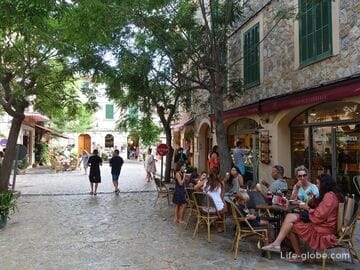Palma de Mallorca or simply Palma is the historical and tourist center of the island of Mallorca, as well as the main city and port of the Balearic Islands.
Palma is one of the oldest cities in Europe, the chronicle of which traces its history back to the Roman conquests in 123 BC.
Today, Palma is one of the most visited cities of the Balearic Islands, keeping in its structure the historical center, where the bulk of the attractions are concentrated, as well as some other attractions, including historical ones.
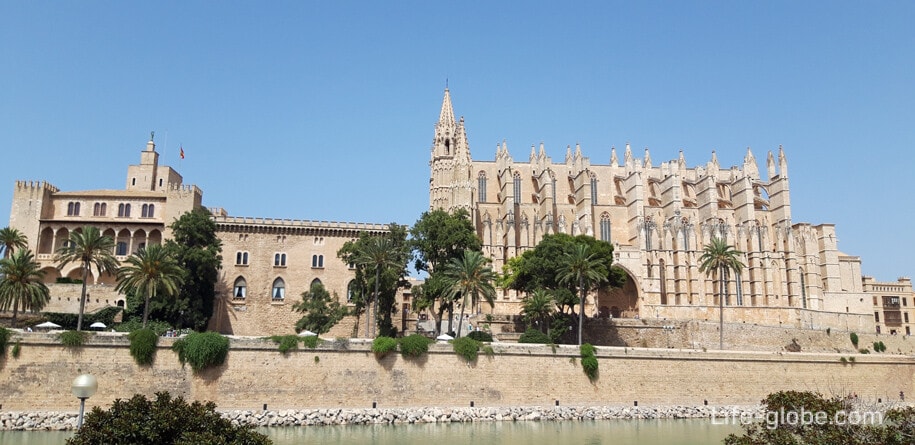
The sights of Palma. Where to go, what to see in Palma
Can Pere Antoni Beach
Of course, the beach is not a tourist attraction, but Can Pete Antoni is the only beach near the center of Palma. The rest of the coast is occupied by the embankment and the port.
The beach of Ca'n Pere Antoni (Platja de Ca'n Pere Antoni) has a length of 735 meters, with an average width of 15-30 meters.
There is fine light sand on the beach. In high season, the beach has all the necessary infrastructure. More about Can pere Anthony Beach...
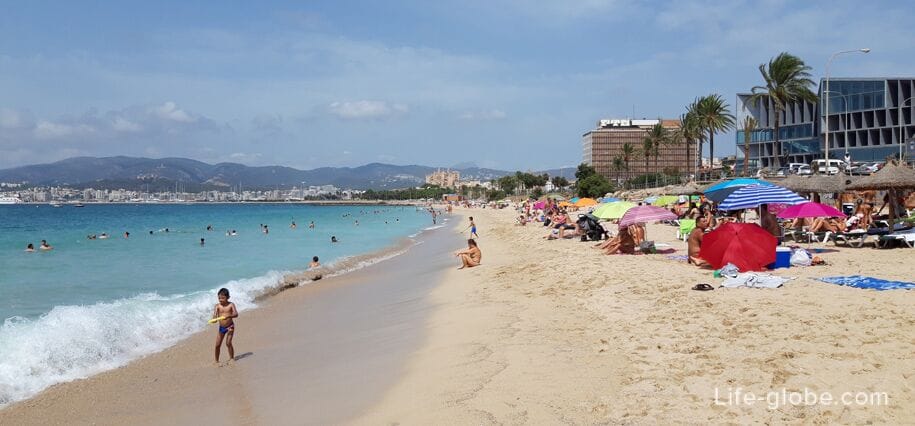
Paseo Maretimo
Along most of the coast of Palma runs the seaside boulevard Paseo Maritimo (Paseo Maritimo).
Along the boulevard there are places for walking and relaxing, sculptures and the port of Palma. More about Paseo Maritimo...
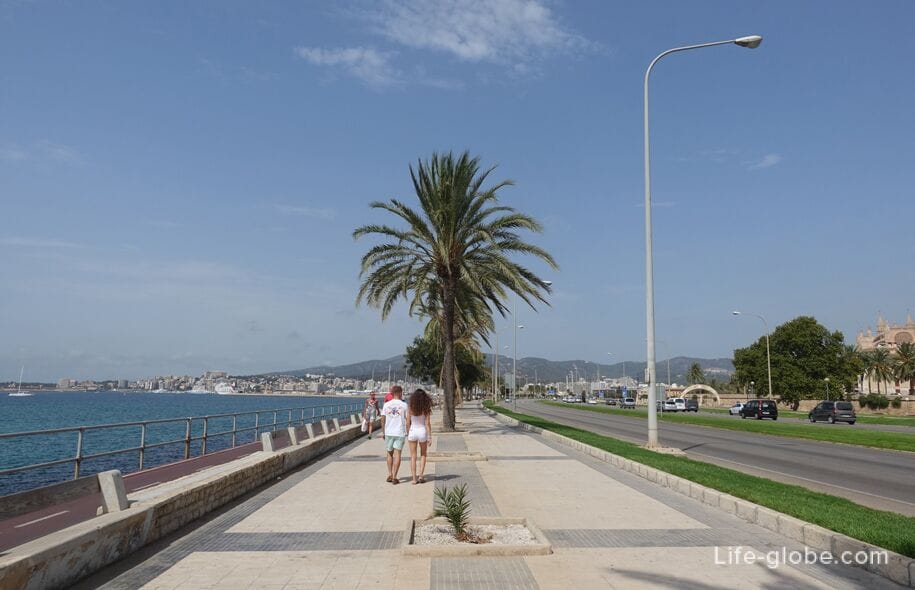
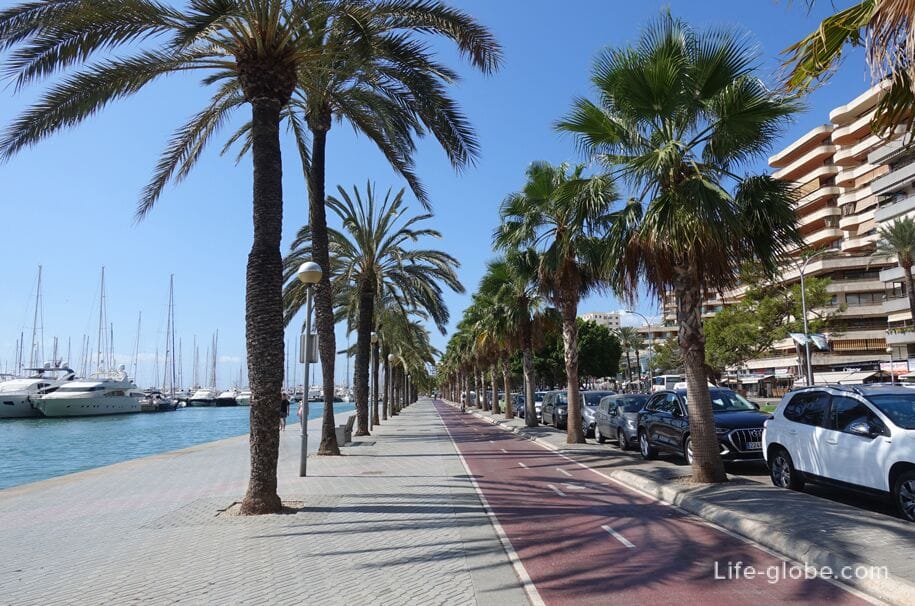
Seaside Park
The Seaside Park (Spanish: Parque del Mar, Catalan - Parc de la Mar), also known as the "Park of the Sea" or the park by the sea, is located near the city walls of the old city of Palma and is one of the largest parks in the city.
The park was built in the 1970s on an empty site, after the construction of the highway and the embankment.
In the park: a salt lake with a fountain, places for walking and relaxing, trees and palm trees, an esplanade, sculptures, several cafes and restaurants and a covered parking lot. More about the Seaside Park...
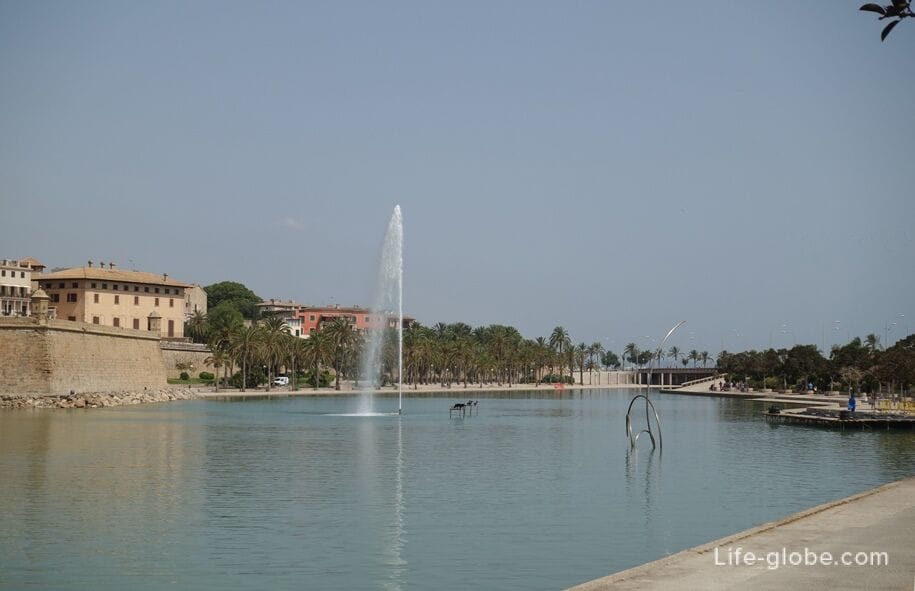
Old Town of Palma
The Old Town of Palma is the center of the city, where the bulk of the most famous and visited attractions of Palma de Mallorca are located.
The old Town of Palma is characterized by boulevards and narrow cobbled streets, small squares, cathedrals and churches, the main of which is the Cathedral of Palma. Also in the old town there are: Almudena Palace, Arab baths, museums and historical buildings, standing in dense rows along the streets and in which cafes, restaurants and bars, shops, boutiques and accommodation facilities (hotels, apartments, guest houses, hostels, etc.) are now located.
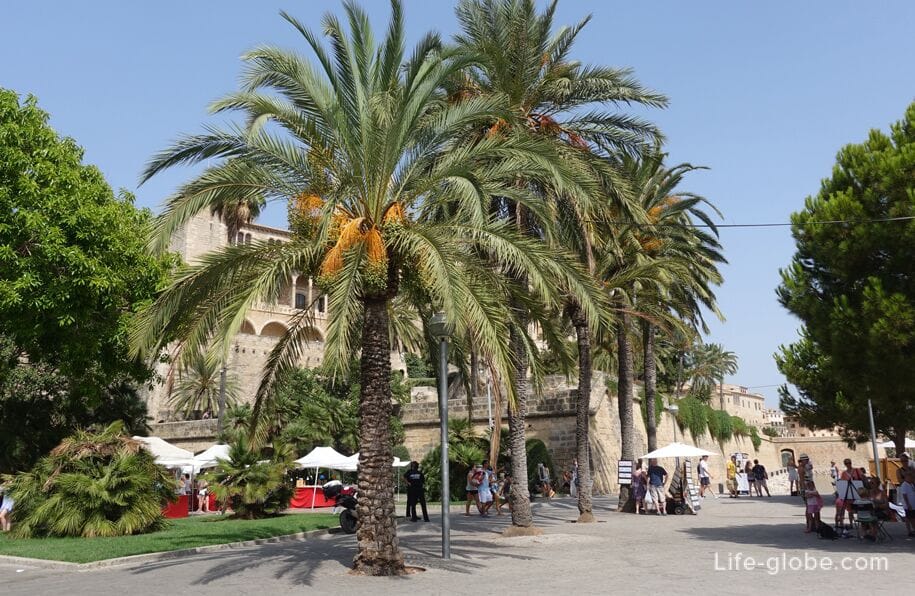
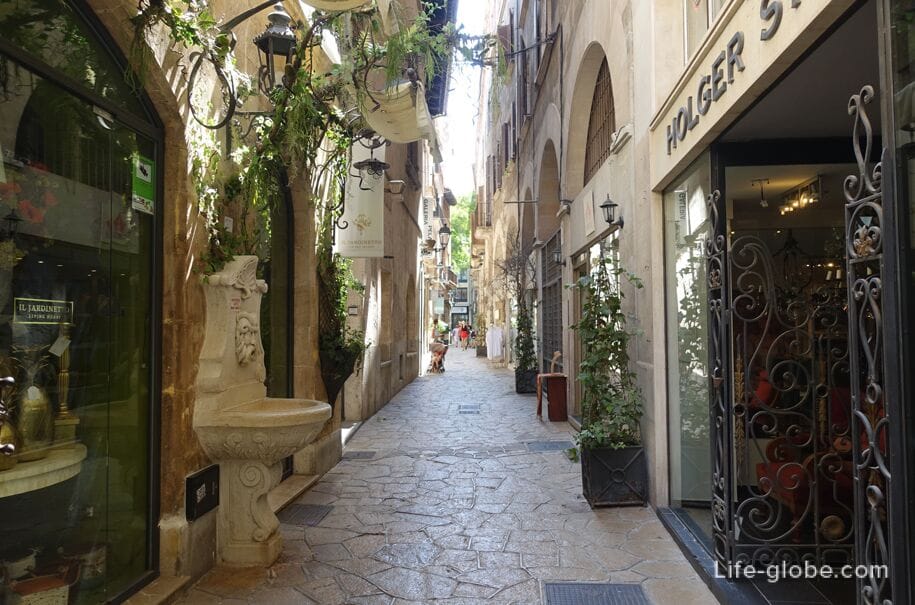
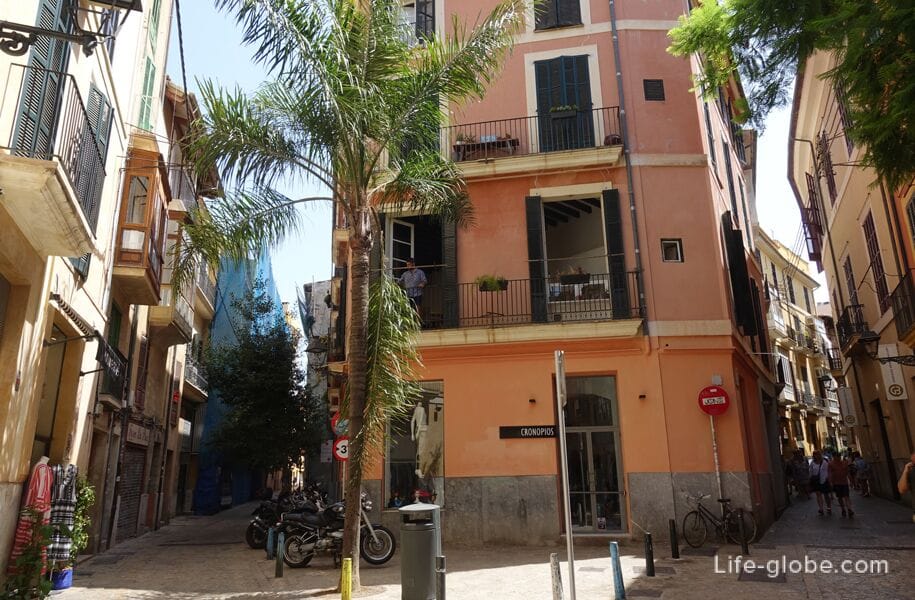
Sights of the old city of Palma
City Wall
The Old Town is separated from the Seaside Park by the old city wall (now restored) along which you can walk and from which you can enjoy beautiful panoramic views, including the Bay of Palma (the Mediterranean Sea).
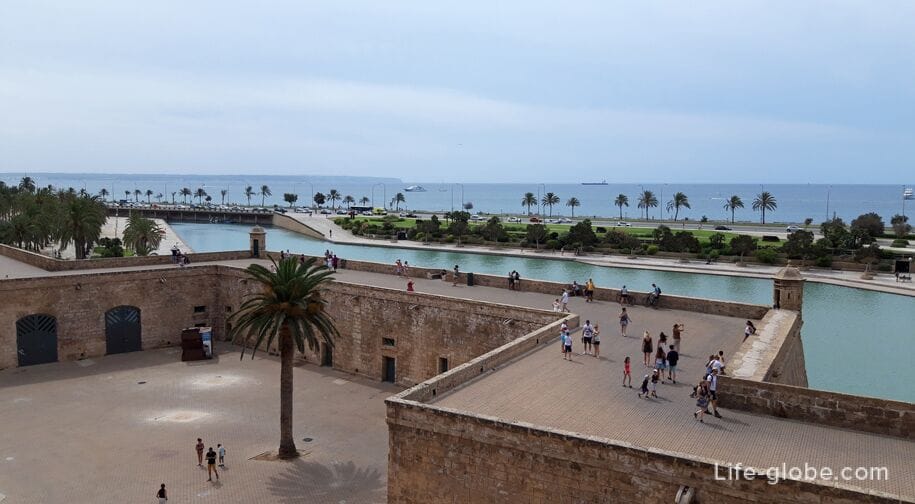
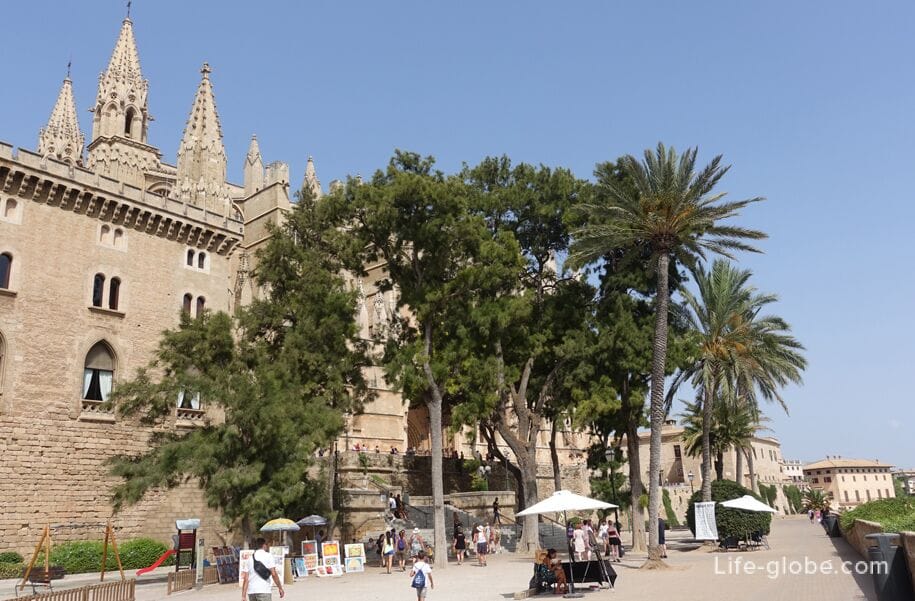
Cathedral of Palma
The Cathedral of Santa Maria, also La Seu (Spanish: Catedral de Santa María de Palma de Mallorca), is the main dominant of Palma.
The Gothic-style cathedral was built on the site of an Arab mosque in 1230-1630.
Over the course of history, various architects have worked on the cathedral, including Antonio Gaudi, who at the beginning of the 20th century adapted the interior of the cathedral to new liturgical and pastoral requirements.
The central nave of the cathedral has a height of approximately 44 meters, which makes it one of the tallest cathedrals in Europe.
Today, the cathedral can be visited for a fee, as well as with an excursion to walk through the "funerary world of the cathedral" or its terraces, from which to admire the panoramas of Palm Trees and the Mediterranean Sea.
Cathedral address: Plaza de la Almoina S/N 07001 Palma de Mallorca.
Cathedral website: catedraldemallorca.
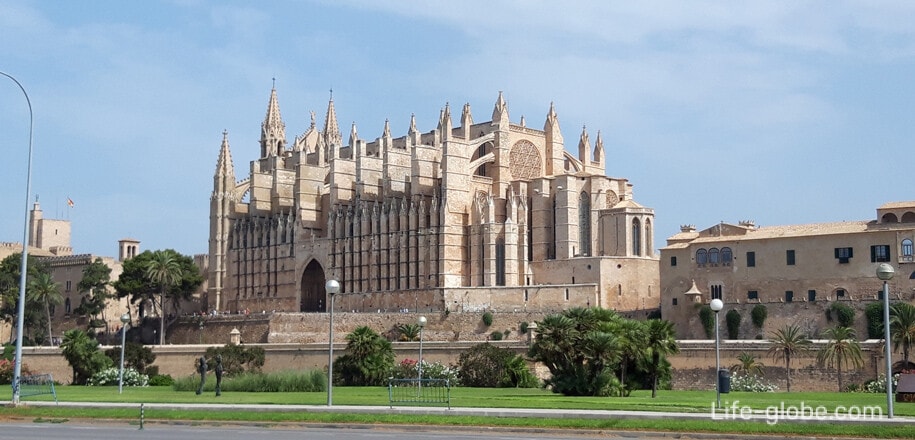

Almudena Palace
The Royal Palace of Almudena or Almudain (Palacio Real de La Almudain) is located opposite the Cathedral of Palma.
The palace was built in 1281 on the foundation of the previously existing Arab fortress-Alcazar and served as the residence of the kings of Majorca.
Today there is a museum in the palace. Entrance is paid.
Palace address: Palau Reial s/n. 07001 Palma de Mallorca.
Museum website: palacio-almudaina.

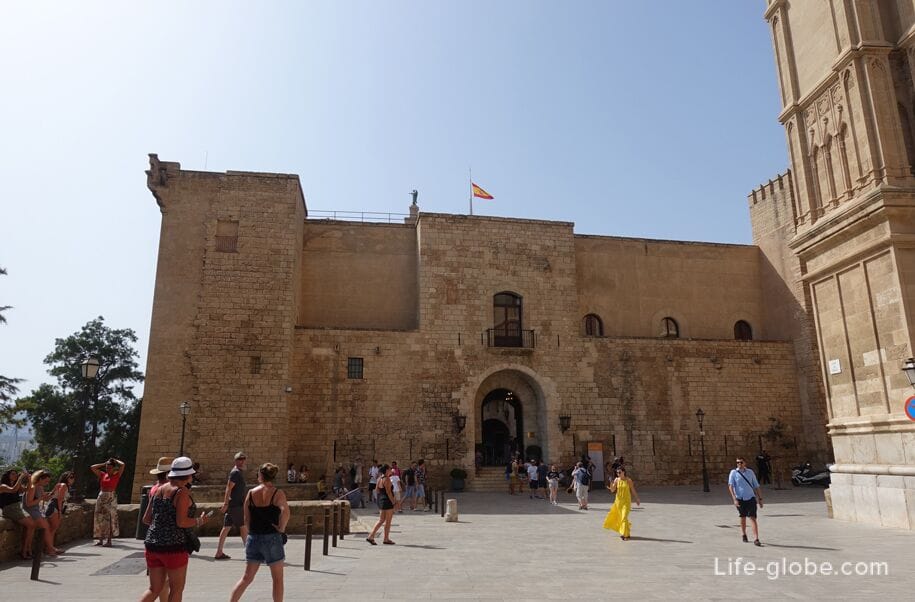
Royal Gardens
The Royal gardens were the gardens of Almudena Palace and are known as Parc Hort del Rey or simply Parc Rey (Parc Hort del Rei / Jardines de S'Hort del Rei).
Currently, the Royal Gardens are a small public space - a shady park area with Arabic-style fountains, a pergola, sculptures, lush vegetation and places to relax. More about the Royal Gardens...

Bishop's Palace
The Bishop's Palace or Bishop's Palace dates back to the final establishment of the episcopal see in 1238 and to Ramon de Torrella (1238-1266) as the first bishop of Majorca.
Since the palace has been modified over the course of history, it does not represent stylistic unity, although it mainly corresponds to the Gothic style.
The building has a rectangular shape and an inner courtyard. Access to the courtyard is through the main facade with a gate built in 1616.
In the center of the courtyard there is a monument to the Sacred Heart of Jesus, created in 1932 in honor of Archbishop Josep Miralles Sberta (1930-1947). The work of sculptor Mikel Arcas. On the pedestal of the monument are the coats of arms of the bishop, the city of Palma, Pope Pius XI and a commemorative inscription.
Today, the Diocesan Museum of Christian Art of Mallorca (Museu Diocesa) is located within the walls of the bishop's palace. Most of the museum's collection is of religious origin, but also contains archaeological objects, decorative art and ethnographic value. The interior spaces of the museum include a series of large Gothic arches and a stained glass window designed by Antonio Gaudi and dedicated to Bishop Pere Juan Campins; on the ground floor there is a corridor with vaulted mares, which used to form part of the palace stables and in which the remains of a wall of the late Roman period are visible, as well as a large gabled window-facade overlooking the sea.
The address of the palace: Carrer del Mirador, 5 (Palau Episcopal) 07001 Palma.
Museum website: museuartsacredemallorca.

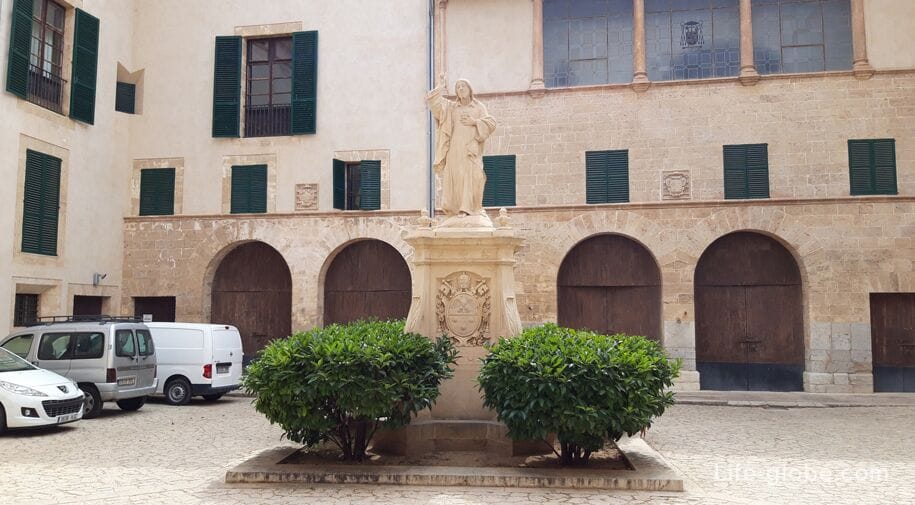
Mark Palace
The Palace of Darkness (Palau March) was once the residence of the rich and famous Markov family (Palau March) and one of the most luxurious mansions of Palma.
The building attracts a beautiful outdoor terrace with views of part of the old town of Palma.
Now the building houses the Parliament of the Balearic Islands and a museum with collections of sculptures, paintings and reconstruction of part of the palace.
The address of the palace: Carrer del Palau Reial, 18, 07001 Palma.
Website: fundacionbmarch.
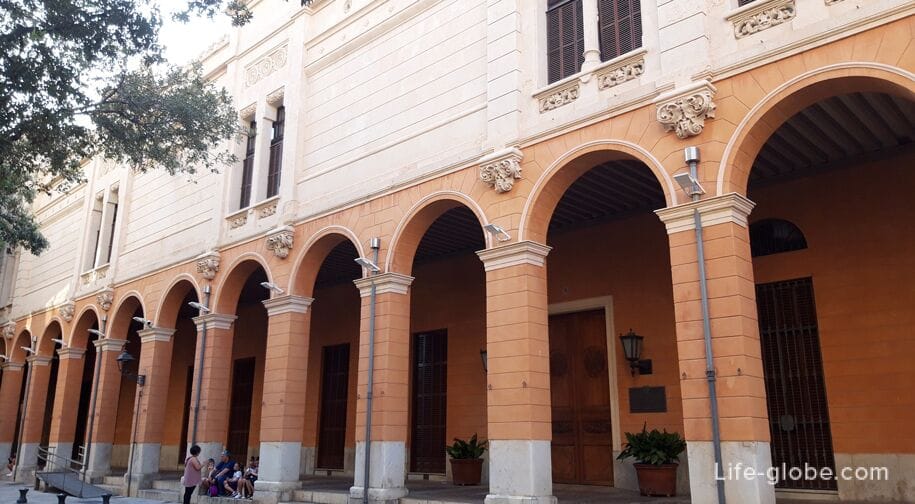
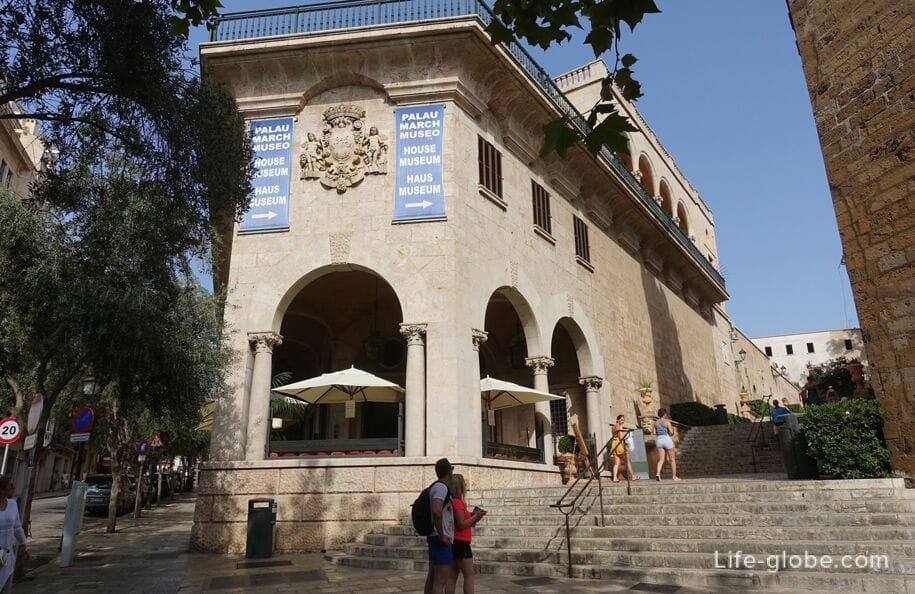
Majorca Museum
The Museum of Mallorca (Museu de Mallorca) is a state-owned and located in a building (the house of Can Aiamans or Ca la Gran Cristiana, built in 1634), which was acquired by the City Council of Palma in 1971 and transferred it to the state to house the Museum of Mallorca.
The house retains most of the pentagonal structure of the Baroque period, which was changed only by modifications made during the 19th century, although Gothic traces are still visible.
Museum address: Calle de la Portella, 5.
Museum website: museudemallorca.
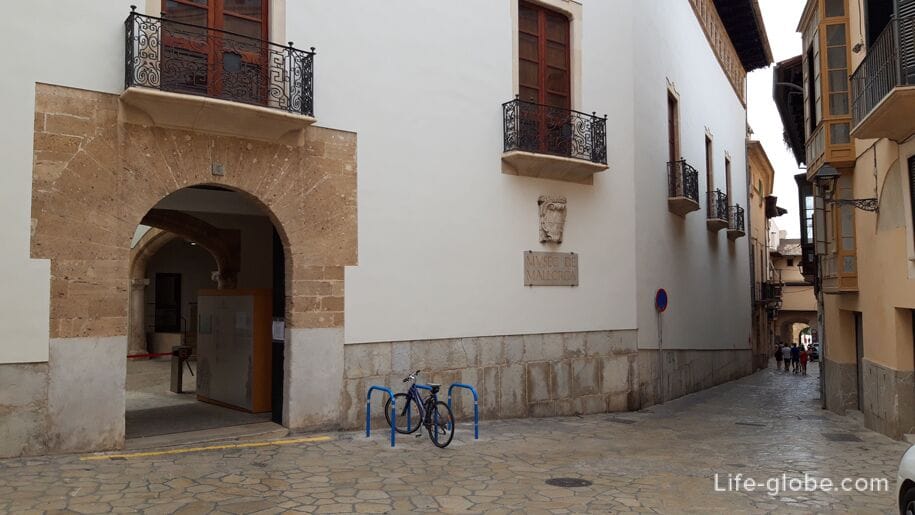
Arab baths
The Arab baths in Palma (Banys arabs de Palma / Arabic baths Palma) are one of the most ancient and symbolic historical monuments in Majorca.
Arab baths are one of the few examples of Muslim architecture on the island and the only baths of this kind in Palma, although it is known that initially there were more baths - at least five.
Only a part of the baths has survived to this day, which is a small structure with several entrances and internal rooms, including a room intended for taking hot baths - the so-called Caldarium.
The Arab baths are a museum. Entrance is paid.
Address of the Arab baths: Carrer de Can Serra, 7. Learn more about Arab baths...
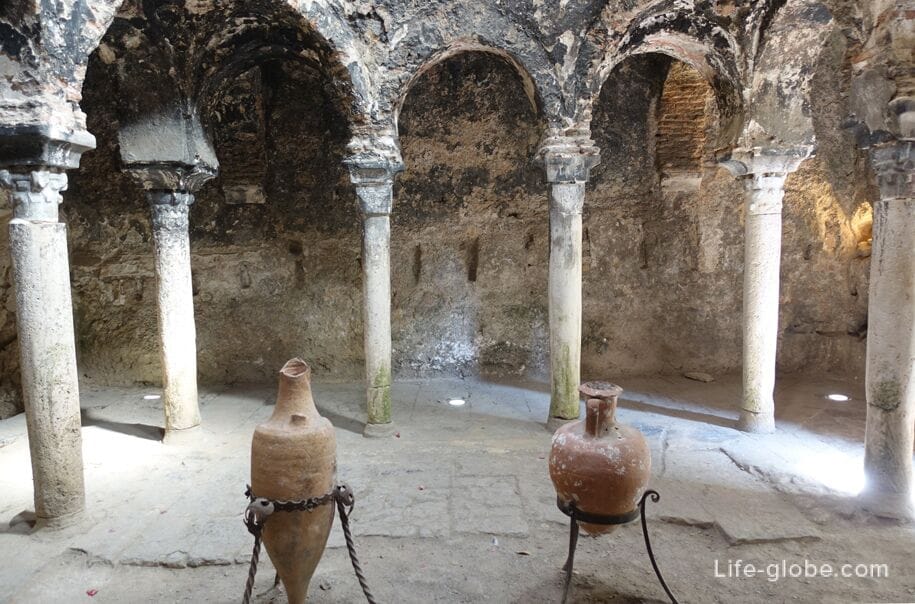
La Lonja Building
The building of La Lonja or "Palma Market" (La Lonja de Palma de Mallorca or Sa Llotja) is one of the masterpieces of Gothic architecture in Majorca.
The building was built between 1426 and 1448 by the architect and sculptor Guillermo Sagrera (hence the name of the street) as the headquarters of the Board of Trade.
The plan of the building is rectangular, with one main interior space divided into twelve sections by peculiar columns.
The exterior of the building is decorated with towers with battlements and small sculptures, has arched windows and doors.
Currently, the building opens its doors only during exhibitions and cultural events.
La address Lonja: Placa de la Llotja, 5.
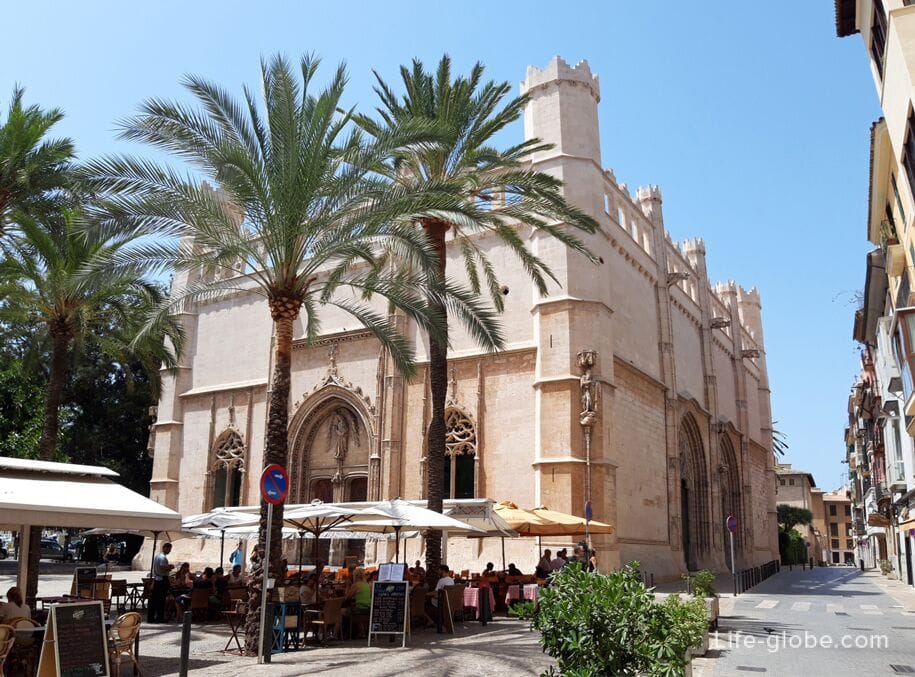
Consulate of the Sea
The Consulate of the Sea (Consulado del Mar) is made in the style of Mannerism and was built in 1669.
Initially, it was the place of the legal and commercial institute of the same name. Since 1983, it has been the seat of the Government of the Balearic Islands.
The unique architecture of the building clearly emphasizes the facade divided into three tiers (floors). The exterior of the building is also notable for the clock tower located on the eastern side of the building.
There are works of art in the consulate. There are also offices and work spaces where a team of people is working on the implementation of a general government project.
Sometimes, during public events, the building opens its doors to the general public.
The address of the Consulate of the Sea: Passeig de Sagrera, 7 / Carrer de la Llotja, 3.
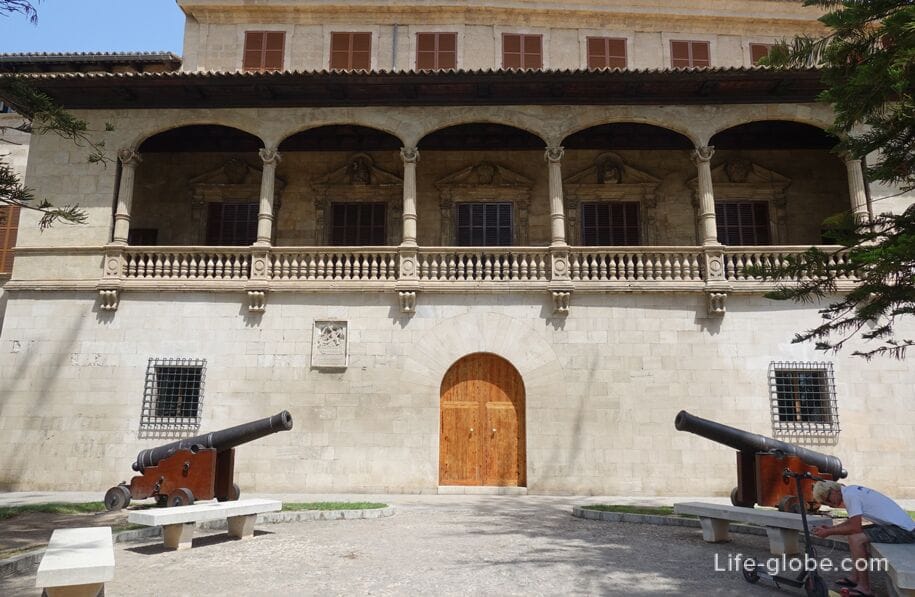
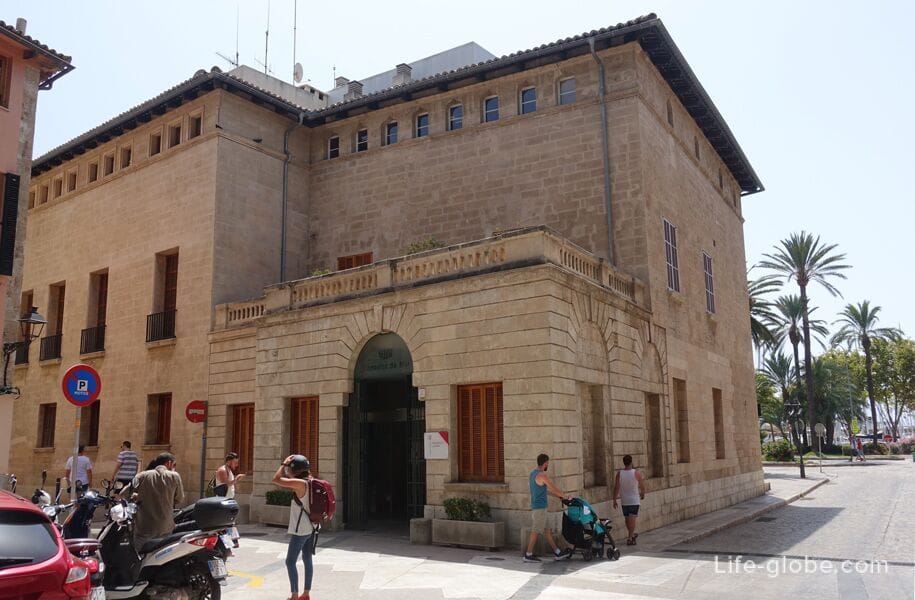
Es-Balouard - Museum of Modern Art in Bastion
The Es Balouard structure was formerly the bastion of San Pedro (Bastion of San Pere or Bastion of St. Peter / Bastio de Sant Pere), which, in turn, was part of the old Renaissance wall of the city.
The bastion was built between 1575 and 1578 in order to strengthen the old defensive wall of the city and was a walled protection and observation building.
Now the former bastion houses the Es Baluard Museum of Modern Art (Es Baluard).
Also in the old bastion there is a panoramic terrace and a restaurant.
The terrace and outdoor areas, as well as the museum premises on some days, can be viewed free of charge.
Es Balouard address: Plaza Porta de Santa Catalina, 10.
Museum website: esbaluard. More about the Es-Balouard Museum...
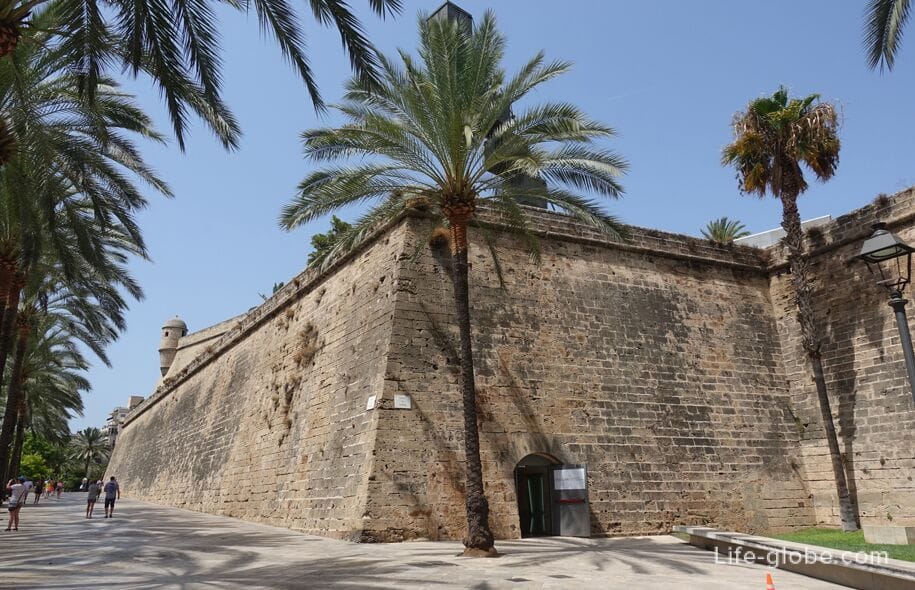
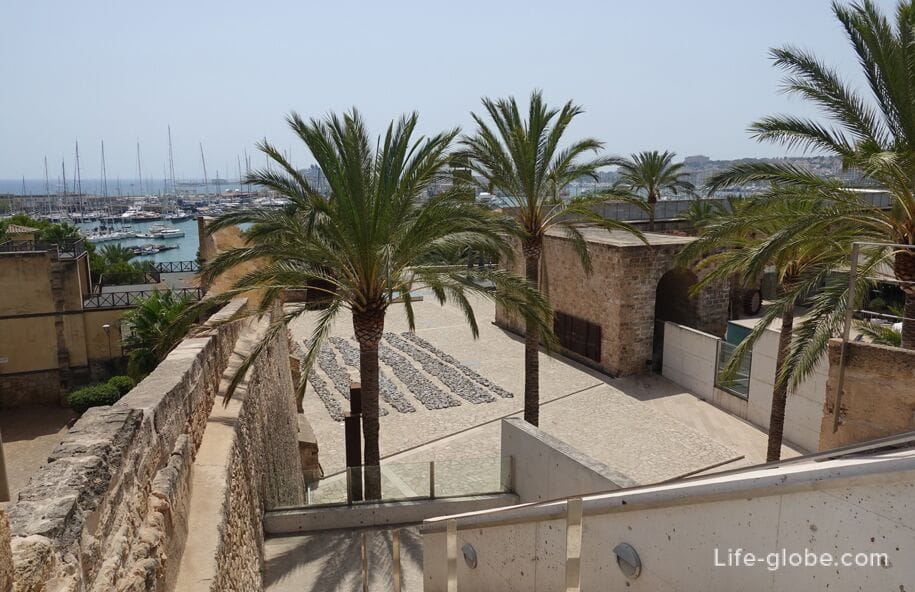
Basilica of St. Francis
The Basilica of St. Francis (Basílica de Sant Francesc) has a 13th-century facade that was renovated after a lightning strike in the 17th century.
The basilica is made in a typical Majorcan style, with a huge sandstone wall and fine carvings with a rose window in the center. The basilica complex includes an inner courtyard.
Inside the church is the tomb of Ramon Lulli (1235-1316), who became a hermit after an unsuccessful seduction trip, and who was stoned to death after he tried to convert Muslims in Tunisia.
Near the basilica there is a statue of another famous major missionary, Fra Junipero Serra, who lived in the city monastery.
Entrance to the basilica complex is paid (5 euros).
The address of the basilica: Plaça de Sant Francesc, 7.
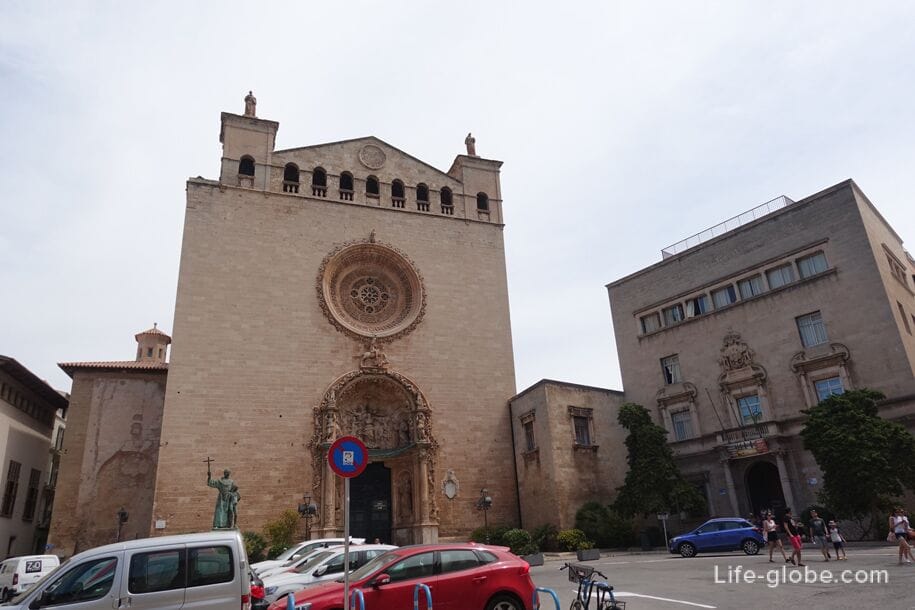
Palma Town Hall
The Town Hall of the city of Palma de Mallorca or the Mayor's Office of Palma (the building of the City Council of Palma - Ayuntamiento de Palma de Mallorca, Catalan name: Ajuntament de Palma) is located on one of the central and busiest squares of the city - Plaza de Cort.
The three-storey town hall building has a Baroque facade with elements of Gothic and Mannerism - a traditional major style. It was built between 1649 and 1680 by architects Pere Baucha, Michele Oliver and Bartomeu Calafat.
A visit to the town hall is possible.
Address of the Town Hall: Plaça de Cort, 1. Learn more about the Palma Town Hall and its visit...
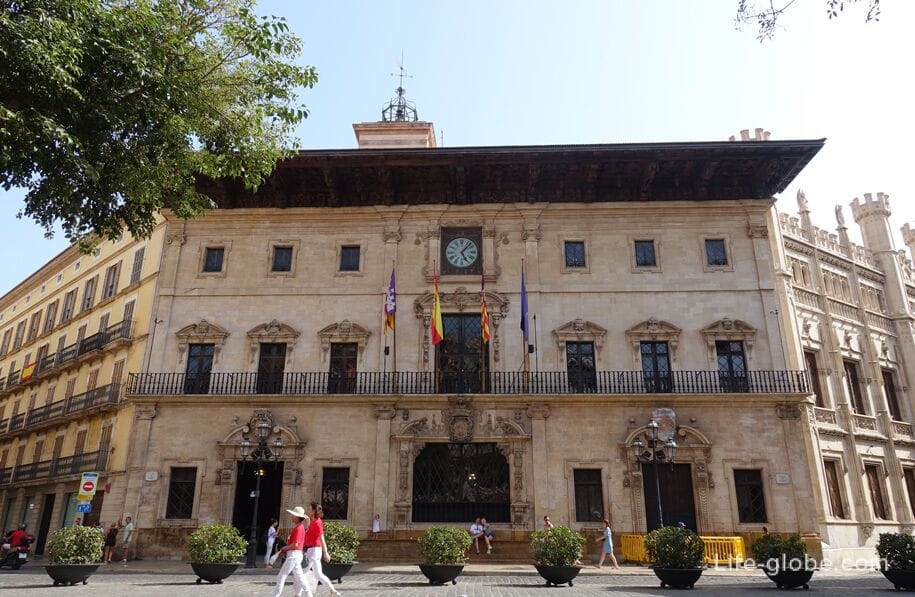
Majorca Council Palace
The Palace of the Council of Majorca (Palau del Consell), which attracts attention with its Neo-Gothic facade with four towers, adjoins the City Hall of Palma from the Royal Palace Street (Carrer del Palau Reial).
The building was built to house the old provincial council. The construction was carried out by architect Joaquin Pavius between the 19th and 20th centuries, and meant a complete reconstruction of the building of the old city prison (1230-1870).
The lobby of the building, which can be visited, is distinguished by a grand staircase leading to the second floor, where a gallery and a meeting room with a great wealth of ornaments are located.
The address of the council building: Carrer del Palau Reial, 1. More about the Majorca Council Palace...

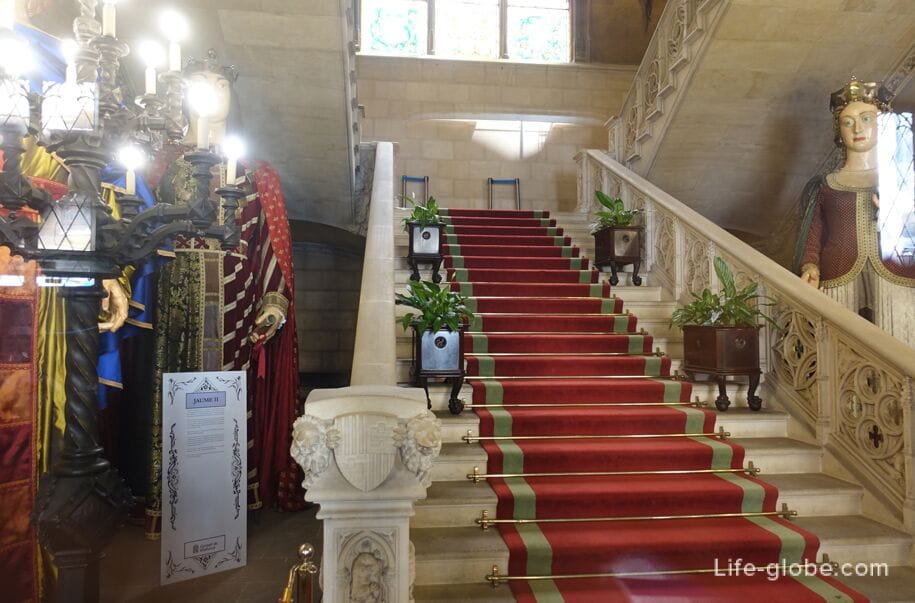
Can Forteza Rey House and El Aguila Building
The House of Kahn Forteza Rey and the Edificio El Aguila are architectural monuments that were erected in 1908-1909.
Since the buildings are located nearby, they are visually perceived as a single architectural ensemble of the modernist style. Facades of buildings are distinguished by abundant sculptural decorations, windows and balconies.
The buildings are located on the Marquis Palmer Square (Placa del Marques del Palmer). More about the buildings of Can Forteza Rey and El Aguila...
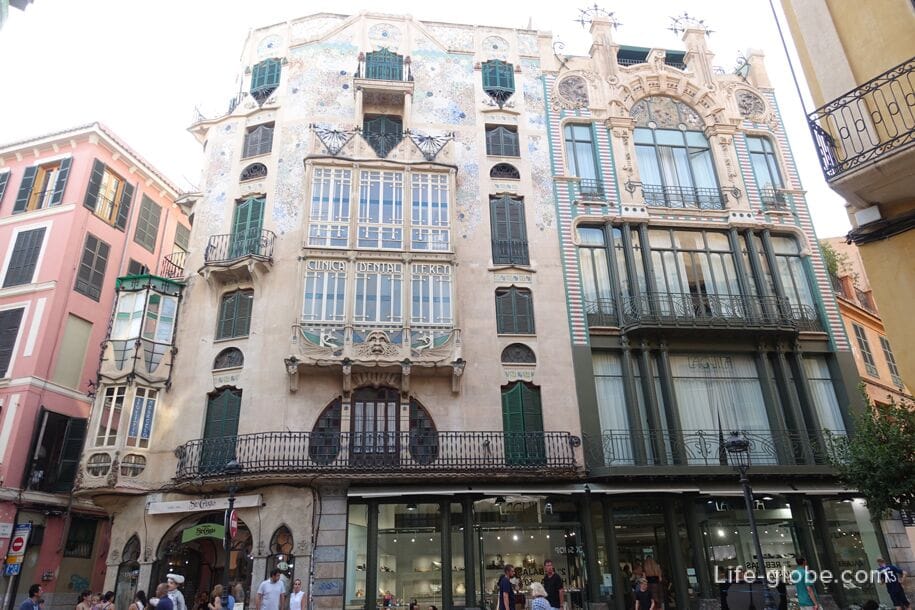
The Can Corbell Building
The Can Corbell building, may be known as Can Corbella (Building Can Corbella) is one of the most original buildings of the historical center of Palma.
Can Corbella is located on the corner of the Court Square and St. Domingo Street (Carrer de Sant Domingo).
The building has 5 floors and a tower. It was built by architect Nikola Literes at the end of the 19th century by order of the rich and famous Corbell family at that time.
The architecture of the house is made in the so-called neo-Mudejar style (Spanish-Moorish style or Moorish Revival style), in which a mixture of Arabic elements and Christian ornaments are visible. Learn more about the building and the St. Domingo Street...
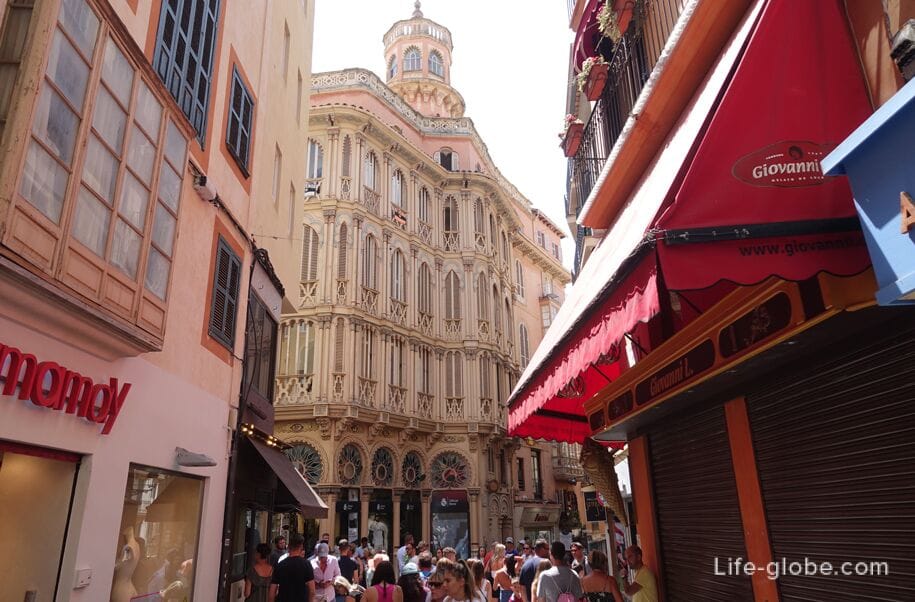
Major Square
Plaza Mayor (Catalan name: Plaça Major), which means "big square" is the main and one of the most visited squares of the city of Palma de Mallorca.
The square has a rectangular shape. Along the perimeter of the square there are 3- and 4-storey buildings with porticos on the ground floors - covered galleries supported by columns. Thanks to these buildings, the square forms an enclosed space. Through the covered galleries (passageways) you can access the neighboring streets.
Cafes, restaurants and shops are located on the ground floors of the square buildings. On the square itself, the public is entertained by street performers, and underground parking and shopping galleries are located under the square. More about the Major Square...
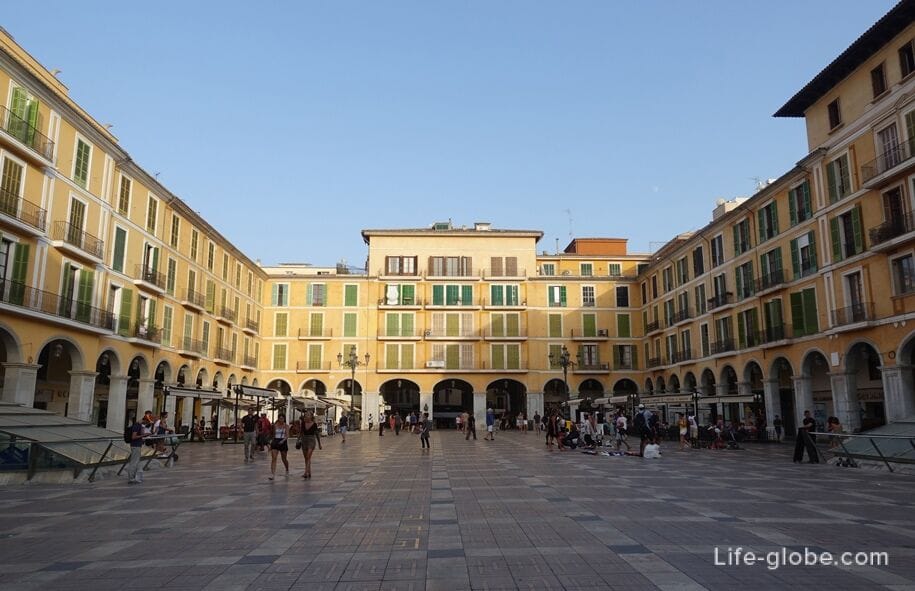
San Miguel Street
San Miguel Street or Sant Miguel Street / St. Michael Street (Carrer de Sant Miquel) is one of the most important shopping, as well as the most visited streets of the historical center of Palma.
The length of St. Michael's Street is about 600 meters. It stretches north from the Mayor Square, to the northern edge of the city center - the intersection of the streets Joan March (Avenida Joan March Ordinas) and Comte de Sallent (Avinguda del Comte de Sallent).
The street is notable: the Museum of the Juan March Foundation (Museu Fundacion Juan March), located in a historic building of the 17th century; St. Michael Basilica (Basilica of St. Michael) on behalf of which have received the name of the whole street; the old convent of San Antonio (Convent Sant Antoniet) with a small parish Church; and the Church of the parish of Santa Catalina de Siena (Esglesia de Santa Catalina de Siena), the Church of St. Margaret (Esglesia de Santa Margalida) and the center of military history and culture of the Balearic Islands (Centro de Historia y Cultura Militar de Baleares), which hold exhibitions and conferences. More about San Miguel Street...

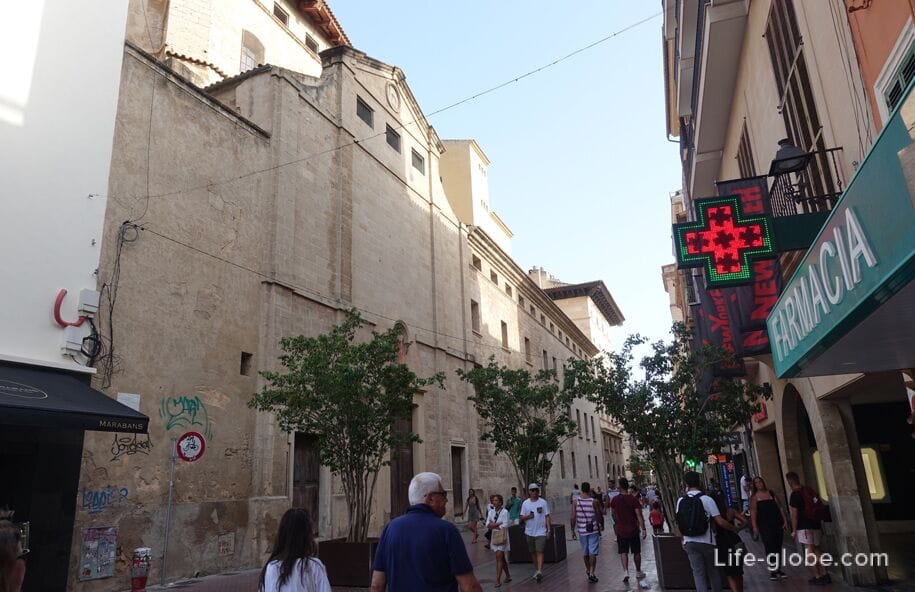
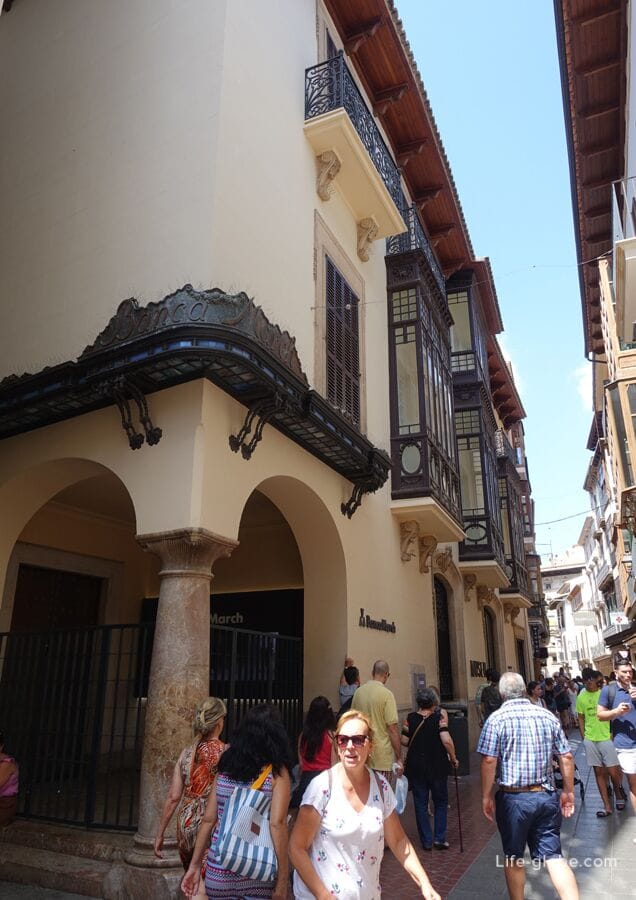
Spain Square
Plaza de Espanya is located on the northern edge of the historic center of Palma and is one of the most important squares of the city.
The square is surrounded by trees and historic buildings, including the Convent of the Capuchins (Convent Frares Caputxins).
In the middle of the square in the center of the fountain there is an equestrian monument to Jaume I, the king of Aragon, Majorca and Valencia, the one who conquered the island from the Moors.
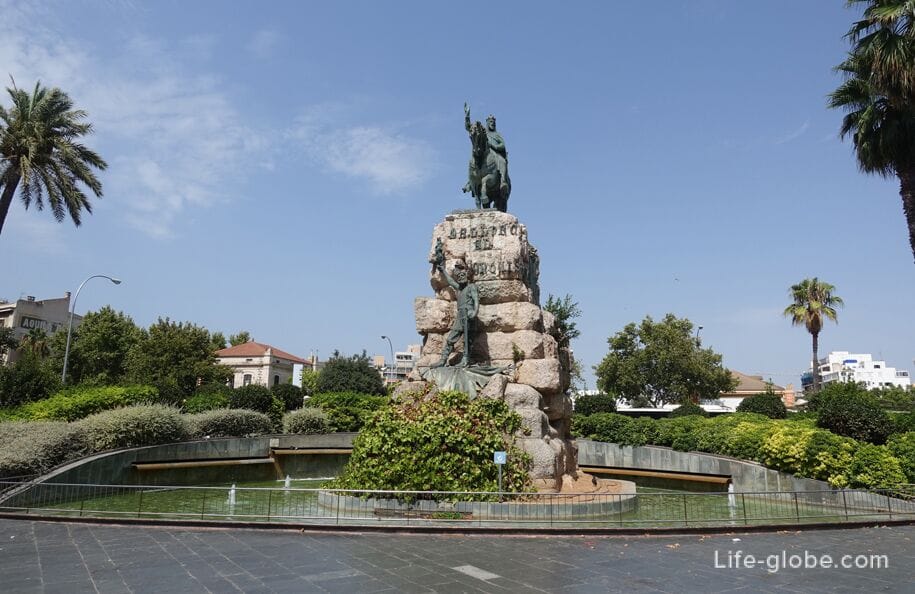
Born Boulevard
Boulevard Born or Paseo del Born (Passeig del Born) is a boulevard (street), which is one of the most visited and busiest streets of the historical center of Palma, as well as one of the most extensive boulevards of the city.
The boulevard consists of a central pedestrian part with shaded areas with seating areas, as well as two traffic lanes on each side of the pedestrian part of the boulevard (one for each direction), one of which is currently also a pedestrian zone.
Along both sides of the boulevard, historical buildings are lined up in a row, on the ground floors of which there are shops, boutiques, cafes and restaurants with open-air tables in the center of the boulevard.
Notable among the historical buildings along the boulevard are the old Born Cinema and the Casal Solleric Palace of the second half of the 18th century in Rococo style during the transition to neoclassicism.
From the side of the Royal Square, the boulevard is decorated with sculptures of sphinxes.
At the end of Born Boulevard is Juan Carlos I Square, notable for a fountain with a high obelisk consisting of two parts that are connected by sculptures of turtles. For this reason, the area is also called Turtle Square.
Near Juan Carlos I Square, Born Boulevard meets Jaime III Avenue (Av. de Jaume III), which is one of the main commercial streets of Palma. More about Born Boulevard...
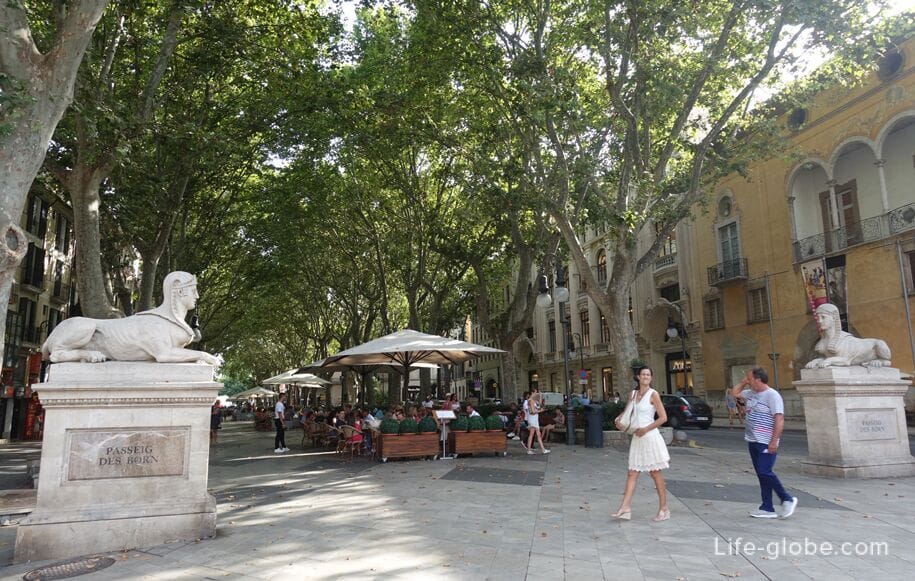

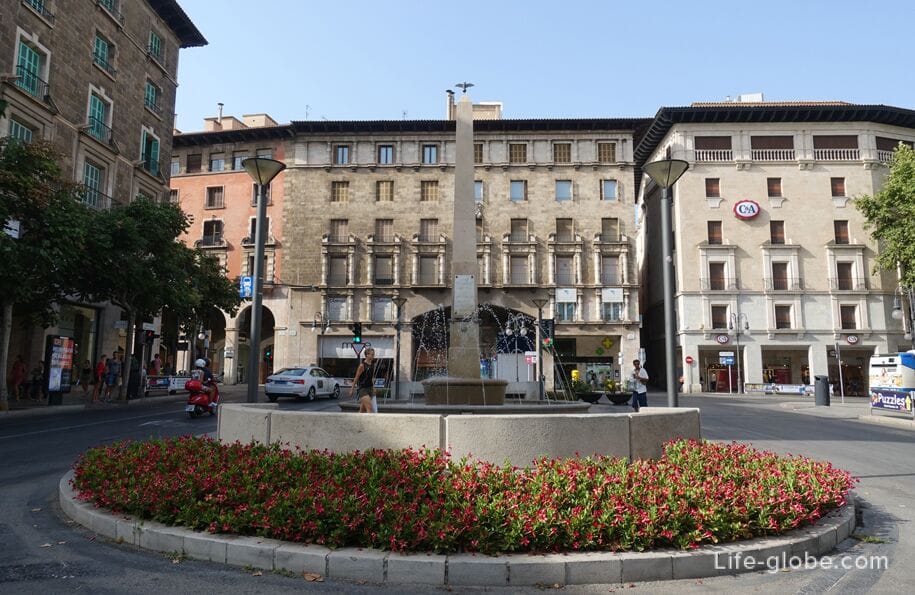
Balaguer House
Can Balaguer or the house of the Marquis Reguer (Cal Marques del Reguer / Can Balaguer) is a historical building, also known as the House of Blanes (Can Blanes, La casa Possible).
The history of the house dates back to the 16th century.
The house has a remarkable courtyard, and going up to the second floor, you can get into the interior of the house, which consists of an interweaving of rooms and a corridor, including an entrance hall, a bedroom, a fireplace and a dining room, decorated in the style of the 19th - early 20th centuries, including furniture and household items.
The house also has three rooms (spaces) that are related to Josepe Balaguer (a musician living in the house in the 20th century): an art gallery, a music room and a Louis XV room.
House address: Carrer de la Unio, 3. More about the Balaguer House...

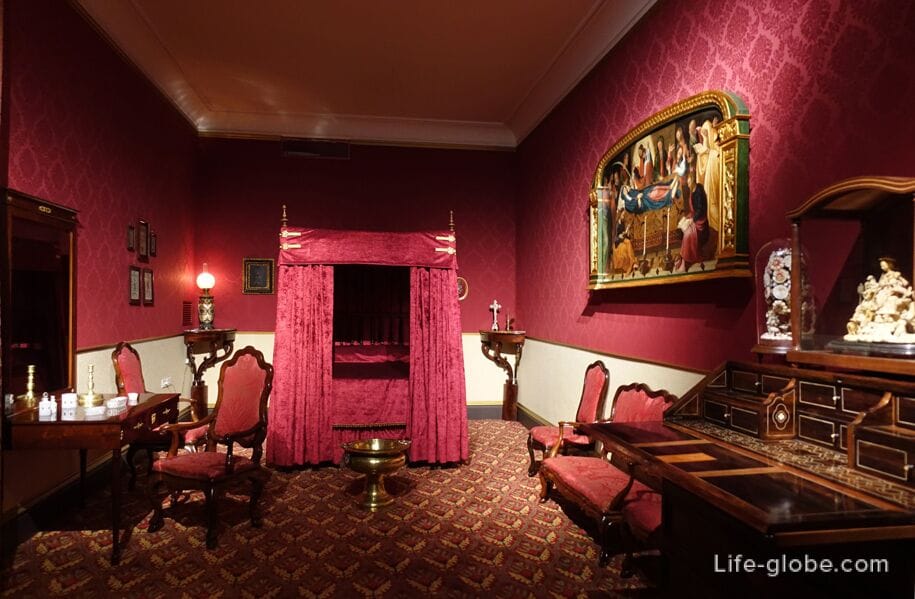
Grand Hotel
The Grand Hotel building is one of the most striking and important examples of modernism on the island of Majorca.
The hotel was designed by architect Luis Domenech y Montaner in 1903. The facade of the building is richly decorated with sculptural elements and ceramics.
The building has been restored and today is a cultural center that contains a permanent exhibition of paintings by the Spanish artist Ermenehildo Anglada Camaras.
Address of the Grand Hotel: Placa de Weyler, 3. More about the Grand Hotel...
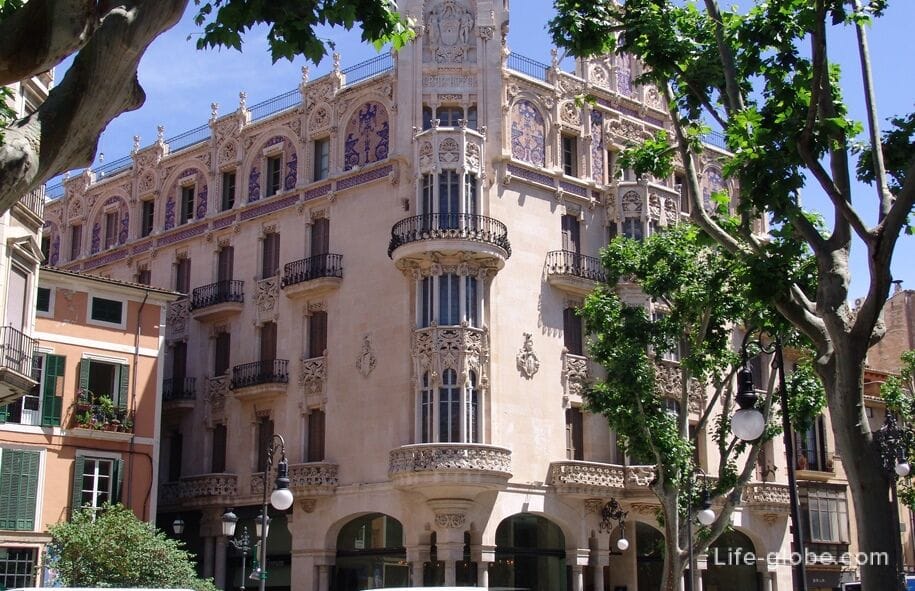
Theater Principal
The Principal Theater or the main theater of Palma (Teatre Principal) was originally opened in 1667 under the name "Casa de les Comedias" and could accommodate 800 people.
The theater has a rich history, including it was destroyed by fire, but then restored according to the old plans. The scene has also been adapted and expanded.
Today it is also an active theater in Palma.
Theater address: Carrer de la Riera, 2.
Theater website: teatreprincipal. More about the Principal Theater...
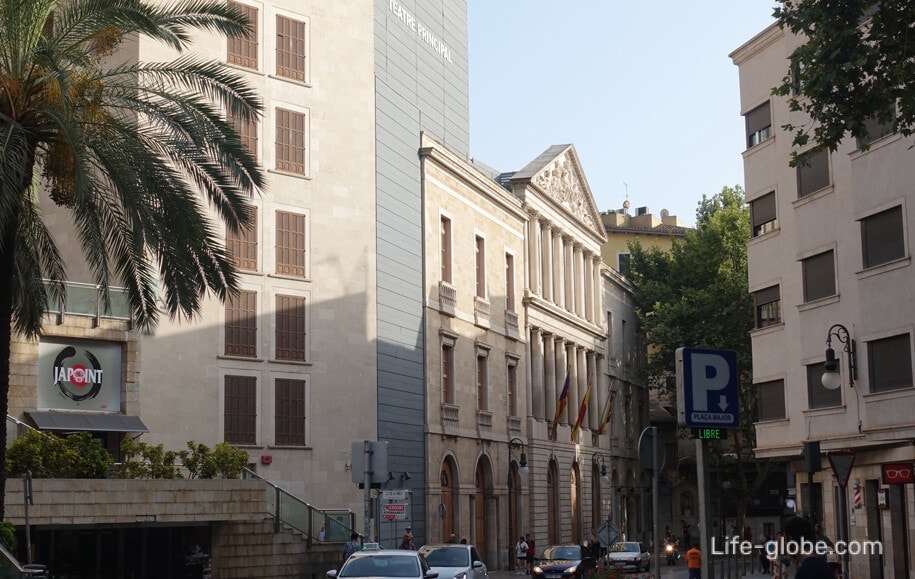
In addition to those listed, in the historical center of Palma there are other museums, churches, a grocery market, as well as historical monuments and buildings, in some of which you can see courtyards characterized by a mixture of elements from different eras. More about the old town of Palma...
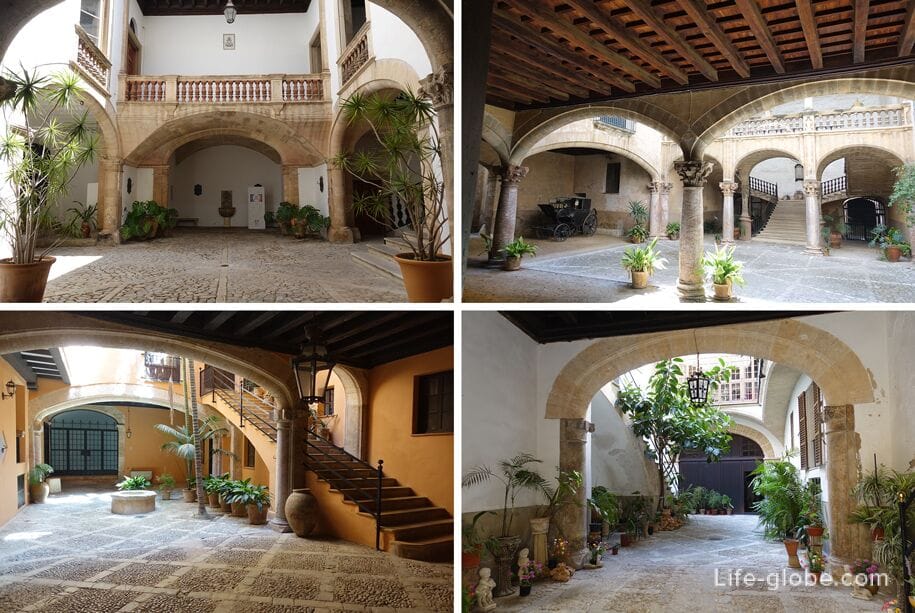
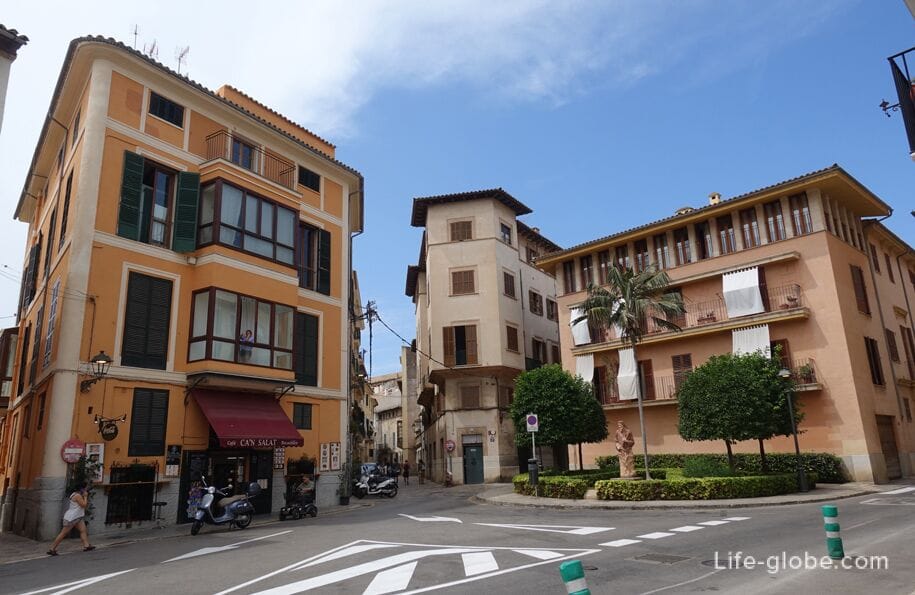
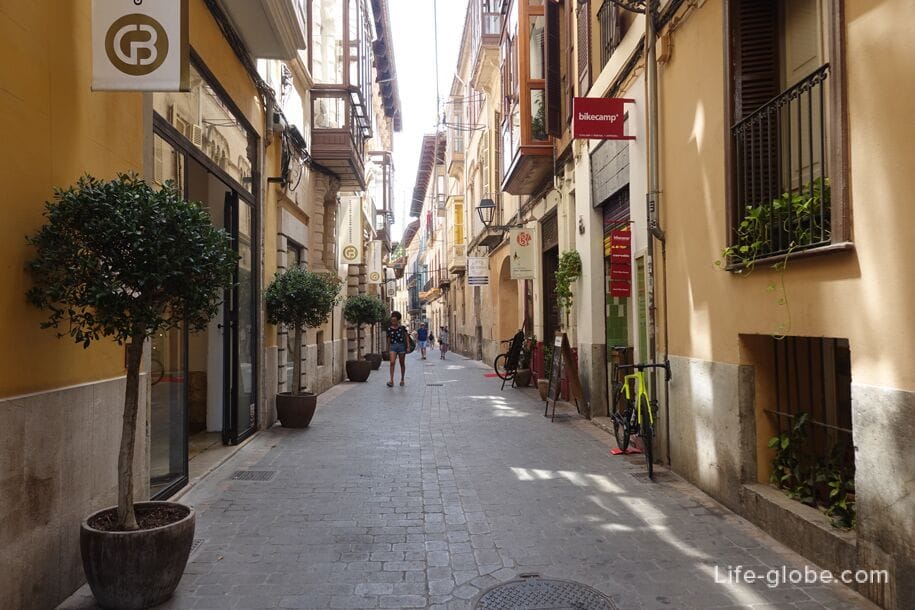
Old mills
The old mills are one of the attractions of the city.
You can see the mills in one of the oldest historical quarters of the city - in the area of El Jonquet or Es Jonquet (El Jonquet, Es Jonquet).
Since the Es Jonket area is located on the slope of a hill running along the Paseo Maritimo embankment, panoramic views of the embankment, the port, the Bay of Palma, as well as partially the old town open from some points of the area (including near the mills).
Also in the area of El Jonquete are: the Municipal Theater of Mari i Terra (Teatre Municipal Mar i Terra), an ethnographic museum telling about the history and operation of mills in Majorca Museu dels Molins - Molí d'en Garleta) and the Plaza dels Rentadors. More about the El Jonket area...
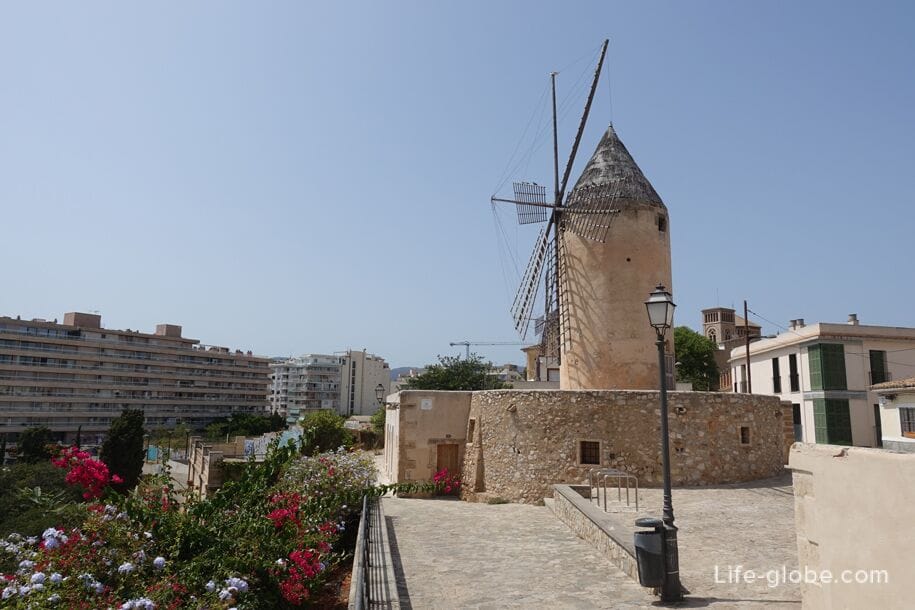

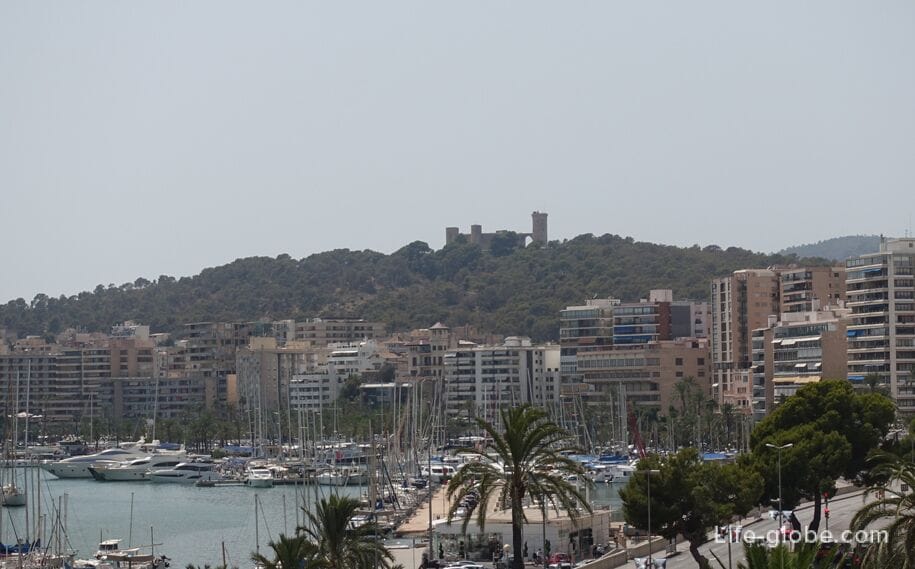
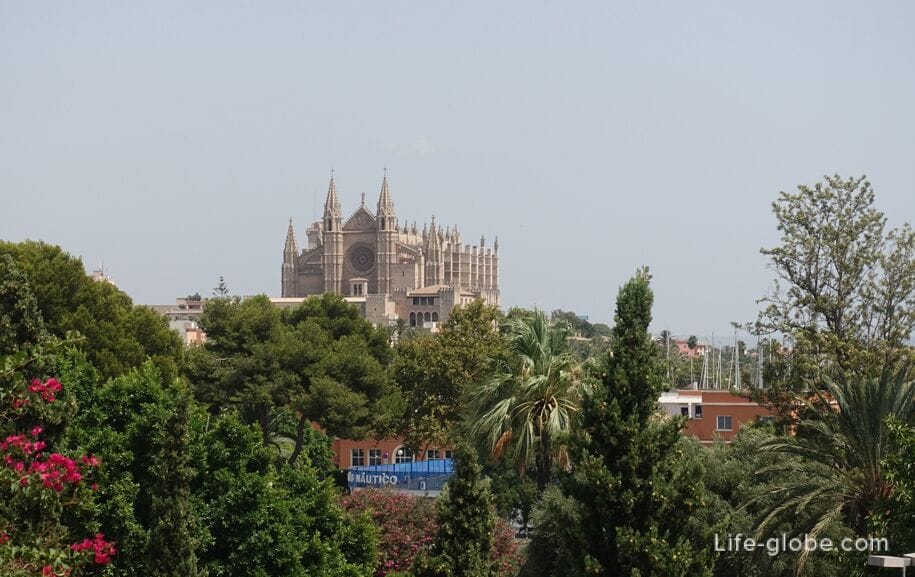
Bellver Castle
On a hill 112 meters above sea level, surrounded by a forest park area, is the castle of Bellver (Castell de Bellver) with a circular plan, which is a fortress in the Gothic style and erected in the early fourteenth century by order of King Jaime II.
Currently, a museum of the history of the city is located within the walls of the castle, exhibitions are held, there is a cafe, and panoramic views open from the territory.
Castle address: Carrer de Camilo José Cela, s/n 07014 Palma.
Castle website: castelldebellver.palma.
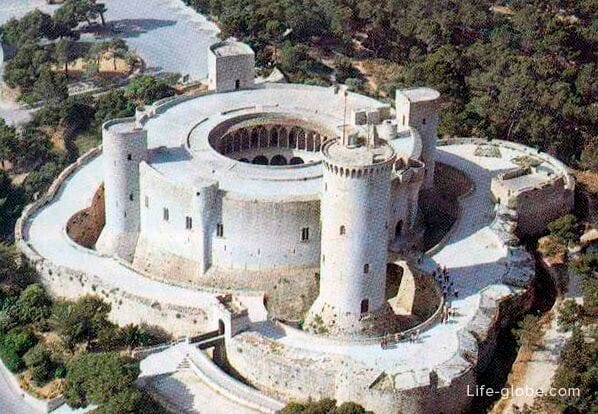
Portopi and Parayes Lighthouse Towers
The Portopi Lighthouse Tower (Torre de Portopi / Porto Pi lighthouse) is a signal tower located on the western edge of the Porto Pi Bay (Portopi district), now the sea station of the city of Palma, and in the era of the Roman Empire it was the main port of the city.
The Portopi Tower is one of the most ancient lighthouses in Spain, has optical instruments, some of the best in Europe. The tower has existed on this site since the 14th century and originally served as a watchtower. Since the 1600s, it has been operating as a lighthouse. Currently, it is not possible to visit the lighthouse tower, since the lighthouse is located on the territory of the naval base.
On the other side of the Porto Pi Bay - the opposite eastern side, there is a second tower - the Torre de Paraires, in the outlines of which traces of the domination of the Roman Empire are preserved. A huge chain was stretched from this tower to the Portopi Tower, thereby closing the entrance to the bay. More about the Portopi area...
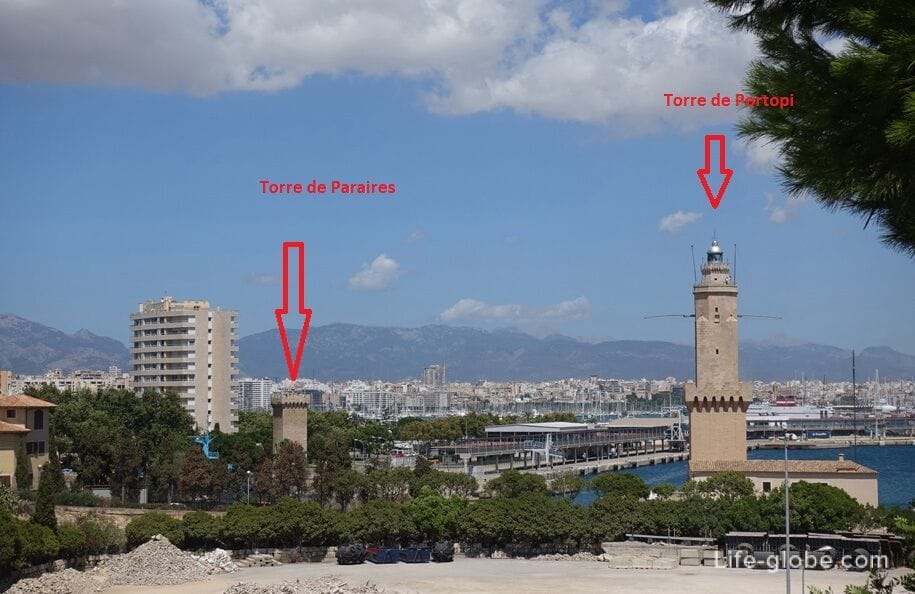
San Carlos Museum
The Military History Museum of San Carlos (Museo Historico Militar de San Carlos) is located in the fortress of St. Carlos, built in the 17th century and now presenting the military history of the Balearic Islands in various monographic halls.
Museum address: Carretera del Dique Oeste, s/n 07015.
Museum website: Madrid/ihycm/Museos.
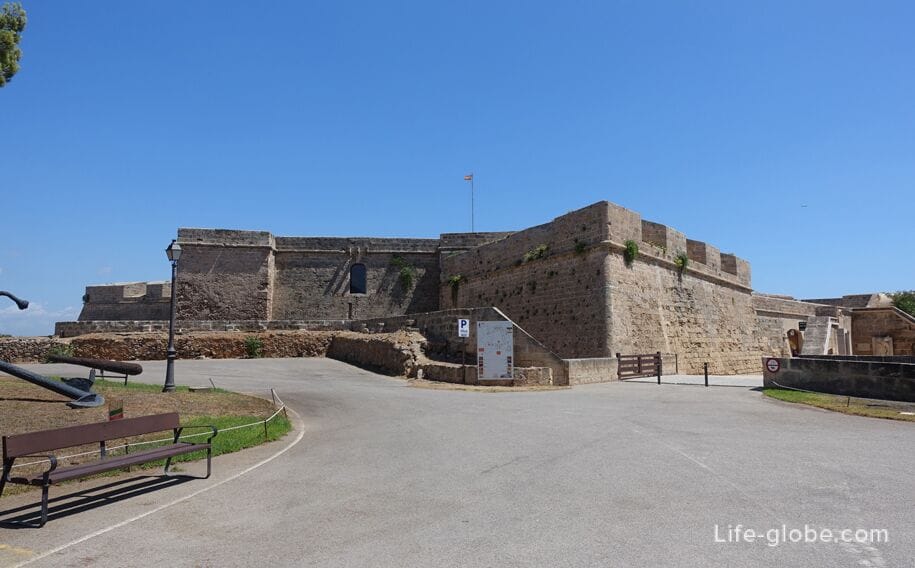

Marivent Palace
The Marivent Palace or the Marivent Palace (Palacio de Marivent) is the pride not only of the Cala Mayor district, but also of the city of Palma, as well as the entire island of Majorca.
The palace was built between 1923 and 1925 by order of the artist John Saridakis, who lived in it until his death in 1963. After that, Saridakis' widow granted the mansion to the government on the condition that the building would become a museum open to the public, dedicated to Saridakis' collections, and would bear his name. These conditions were fulfilled until 1973, until the moment when the province handed over the mansion to the then princes of Spain. After the transfer, the mansion was turned into a summer royal residence and renamed "Marivent", which means "palace of the sea and wind". The descendants of Saridakis challenged this decision, and insisted on the return of the movable heritage (Saradakis collection).
Now the mansion is a national treasure, the summer residence of the Spanish royal family and a venue for receptions and interviews of monarchs.
Near the castle there are the gardens of the same name of the Marivent Palace (Jardins de Marivent), which are now available to the public. The gardens of the palace can be visited free of charge at certain hours and with the exception of some days of the year.
Address of the gardens Marivent: Avinguda de Joan Miro, 229, Cala Mayor.
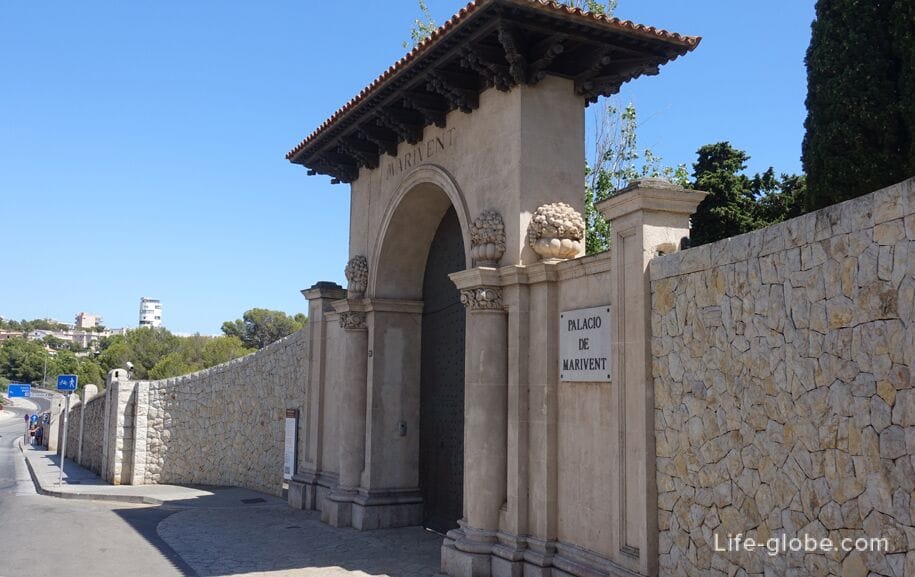
Panoramic staircase
The panoramic staircase is not a well-known landmark and is located near the western outskirts of the city of Palma in the area of Cala Mayor, and in the literal sense is not a landmark at all. Nevertheless, the stairs offer picturesque panoramic views of the Mediterranean Sea, Cala Mayor beach, the coast and the surrounding area.
From the center of the Cala Mayor area, several roads lead to the Cala Mayor beach (Avinguda de Joan Mirj Street), one of which flows into a staircase with panoramic views (Carrer Bernat de Santa Eugenia Street).
In addition, the beach of Cala Mayor is one of the most picturesque near the center of Palma.
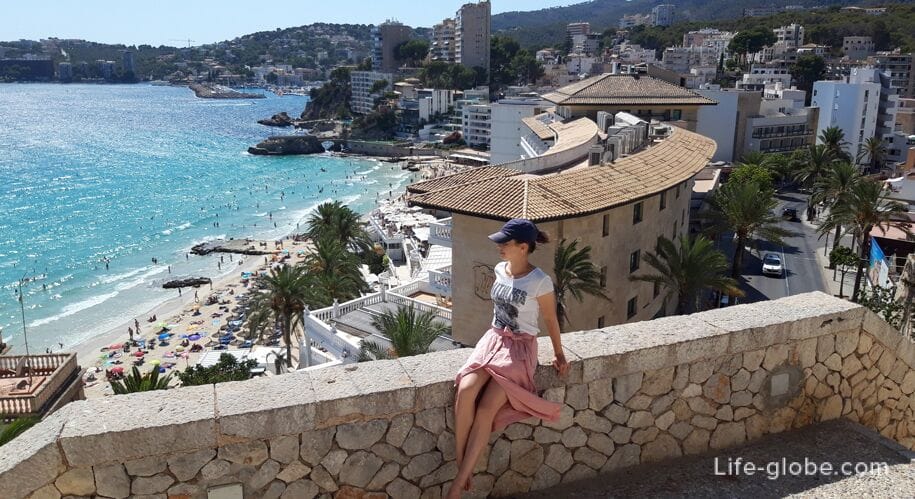
Near Palm Trees you can visit
- the caves of Genoa (Cuevas de Genova), located in the residential quarter of the same name, accidentally discovered during the construction of a well in 1906 and forming underground galleries of calcareous origin, connected by natural corridors.
The caves have a walking route of almost a kilometer and descend to a depth of 36 meters.
Website: cuevasdegenova;
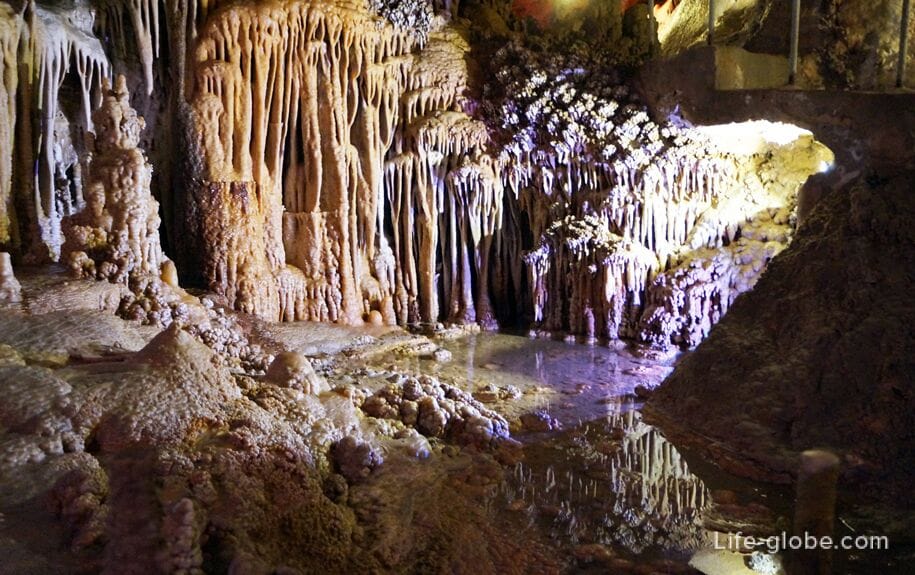
- The Palm Aquarium, located in the resort town of Can Pastilla.
Aquarium address Palm trees: Carrer de Manuela de los Herreros, 21.
Palm Aquarium website: palmaaquarium.

All accommodation facilities in Palma de Mallorca, including in the historical center, near the beaches and more remotely from those, can be viewed and booked here







